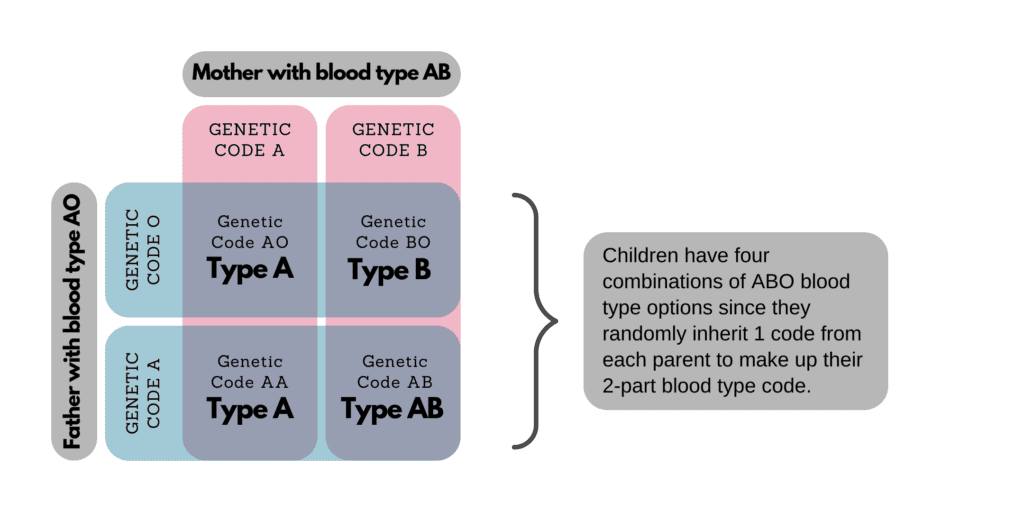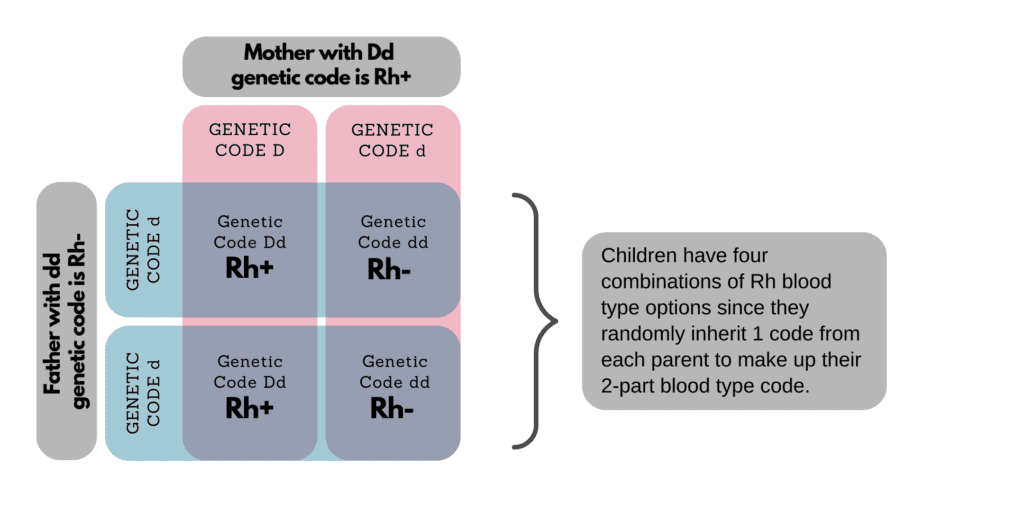How did I get my blood type?
A person’s blood type is determined by how the genetic “code” of each parent is combined and passed on to their children. This genetic code is what determines much of each person’s physical and personality traits.
When we talk about blood type, we are usually referring to both the ABO and Rh parts of our blood type. The ABO part refers to which ABO proteins are on our red blood cells: A, B, A and B, or none (O). The Rh part of our blood type refers to whether we have the Rh, or D protein, on our red blood cells. Our blood type will be Rh positive (+) or Rh negative (-) based on whether we have the D protein or not, respectively.
Let’s discuss this in terms of an individual’s ABO blood type:
Your ABO blood type is determined by whether you inherited an A, B or O from each of your parents. Since you get one of these blood type “codes” from each parent, the genetic makeup of your blood type is a combination of two of the above three blood type options (A, B, or O). While the presence of A or B in your genetic code will result in you having A or B proteins expressed on your red blood cells, the O represents nothing being added to the outside of your red blood cells. Think of the O as a placeholder in your blood type genetic code – it takes up space in the blueprint but doesn’t actually result in anything being added to your red blood cells.
So, why is this important for blood donation and transfusion? Well, soon after we are born, our body makes an immune response to either the A or B blood proteins that we do not have on our cells. If we are blood type O, our body thinks that both A and B are foreign organisms and will attack and reject it. This is why blood type O donors are universal donors – they do not have any A or B proteins on their cells, and so all patients can receive O red blood cells. Conversely, type O blood recipients can only receive O red blood cells, because their body will reject any blood that has A or B proteins on it.
ABO blood type inheritance example:

What about Rh inheritance?
The Rh part of a person’s blood type is what decides whether we have the D protein present on our red blood cells. The inheritance of Rh is like ABO inheritance, except there are only two options to inherit for our Rh genetic code: D or d. The presence of D in our code will cause the D protein to be on our cells, and the presence of d is simply another placeholder for which nothing gets added to our cells. Also, it is important to know that the presence or absence of the D protein on our cells is what determines if a person is Rh+ (has the D protein) or Rh- (lacks the D protein).
Each of our parents has two of the above options (D or d) in their Rh blood type genetic code, and their children will receive one code from each parent, ultimately determining their Rh blood type.
Rh inheritance example:

Our body treats the D protein a little differently than the A and B proteins. Instead of making immunity against it after birth, we must first be exposed to the D antigen to generate immunity against it. Therefore, most people who are Rh- will only reject Rh+ blood (with the D on cells) after they have been exposed to Rh+ blood through pregnancy or transfusion.
References:
AABB Technical Manual, 19th ed. 2017. Edited by Fung M, Eder AF, Spitalnik SL and Westhoff CM.
